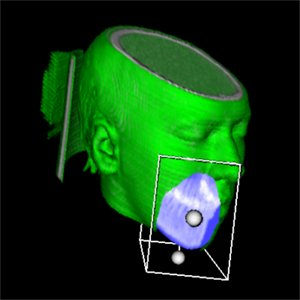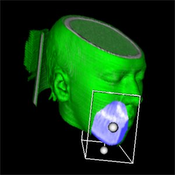Information
- Publication Type: Conference Paper
- Workgroup(s)/Project(s): not specified
- Date: November 2003
- ISBN: 3898380483
- Publisher: infix
- Editor: T. Ertl, B. Girod, G. Greiner, H. Niemann, H.-P. Seidel, E. Steinbach, R. Westermann
- Booktitle: Workshop on Vision, Modeling and Visualization
- Pages: 529 – 536
- Keywords: focus+context techniques, clipping, hybrid volume rendering
Abstract
In this paper, a simple and efficient solution for combining shear-warp volume rendering and the hardware graphics pipeline is presented. The approach applies an inverse warp transformation to the Z-Buffer, containing the rendered geometry. This information is used for combining geometry and volume data during compositing. We present applications of this concept which include hybrid volume rendering, i.e., concurrent rendering of polygonal objects and volume data, and volume clipping on convex clipping regions. Furthermore, it can be used to efficiently define regions with different rendering modes and transfer functions for focus+context volume rendering. Empirical results show that the approach has very low impact on performance.Additional Files and Images
Additional images and videos
Additional files
Weblinks
No further information available.BibTeX
@inproceedings{Bruckner-2003-The,
title = "The Inverse Warp: Non-Invasive Integration of Shear-Warp
Volume Rendering into Polygon Rendering Pipelines",
author = "Stefan Bruckner and Dieter Schmalstieg and Helwig Hauser and
Eduard Gr\"{o}ller",
year = "2003",
abstract = "In this paper, a simple and efficient solution for combining
shear-warp volume rendering and the hardware graphics
pipeline is presented. The approach applies an inverse warp
transformation to the Z-Buffer, containing the rendered
geometry. This information is used for combining geometry
and volume data during compositing. We present applications
of this concept which include hybrid volume rendering, i.e.,
concurrent rendering of polygonal objects and volume data,
and volume clipping on convex clipping regions. Furthermore,
it can be used to efficiently define regions with different
rendering modes and transfer functions for focus+context
volume rendering. Empirical results show that the approach
has very low impact on performance.",
month = nov,
isbn = "3898380483",
publisher = "infix",
editor = "T. Ertl, B. Girod, G. Greiner, H. Niemann, H.-P. Seidel, E.
Steinbach, R. Westermann",
booktitle = "Workshop on Vision, Modeling and Visualization",
pages = "529--536",
keywords = "focus+context techniques, clipping, hybrid volume rendering",
URL = "https://www.cg.tuwien.ac.at/research/publications/2003/Bruckner-2003-The/",
}


 Paper
Paper
:thumb175.png)
:thumb175.png)
:thumb175.png)
